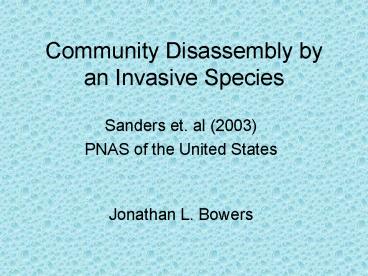Community Disassembly by an Invasive Species PowerPoint PPT Presentation
1 / 13
Title: Community Disassembly by an Invasive Species
1
Community Disassembly by an Invasive Species
- Sanders et. al (2003)
- PNAS of the United States
Jonathan L. Bowers
2
Effect of Invasion on Community Structure
- Not well understood
- Many studies of invasive processes and their
effects are done on the fly (reactionary) - No pre-invasion community data
- Only qualitative estimates of effects of
invasion need for long-term study of community
structure pre-, during, and post-invasion
3
Arguments against Community Disassembly Studies
- Previous studies attempting to explain overall
effects of invasive species on community
structure and function are retroactive analyses
with no pre-invasion data to comparatively
analyze current network assembly and function - Fukami and Morin 2003 suggest that low
productivity and low biodiversity in systems may
occur as a result of the history of community
assembly in a specific system - This is one of a large number of potential
factors - Disturbance occurrence and frequency
- Spatial scale
- Niche specialization
- Some studies have not comparatively analyzed
species composition and community assembly in
intact regions where invasion has not been as
successful
4
Sanders et. al (2003)
- Test subject
- Linepitheda humile (Argentine ant)
- Native to Argentina, Uruguay, Paraguay, and parts
of Brazil - Usually displaces many or all native ant species
during invasion - 7-year study conducted on the effect of Argentine
ant invasion on native ant community composition
and structure
5
Study Sites
- Research conducted at Jasper Ridge Biological
Preserve (northern CA) - Sample plots of 20 meter radii were monitored
twice a year (7 years total) - Located in the center of over 100 1-hectare
quadrats - Observation either included a 5 minute search or
stimulus to draw ants (honey) in the absence of
ants during an active search
6
Analysis
- Simulated communities were analyzed using a
Standardized Effect Size (SES) - SES is a measure of the effects observed across
simulated control and treatments groups - Comparatively analyze control vs. treatment on
the same scale - Species Co-Occurrence
- To quantify this effect, species
segregations/aggregations were observed in intact
and invaded plots - L. humile not incorporated into co-occurrence
model, but was instead just the indicator of
invasion
7
Results
- Analysis of pre- and post-invasion data showed
trends from segregation in pre-invasion plots to
a community structure of random assignment
(aggregated sub-communities) in post-invasion
plots - Disassembly of intact community (network)
structure - Series of indirect cascades likely to lead to
lowered species abundance and a decrease in
biodiversity as indicated in previous
observations (Japan, New Zealand, Easter Island) - Concluded that this disassembly is rapid in
nature, usually within 1 year of invasion - Rapid effect on community structure through
interspecific resource competition
8
Results (Cond)
Table 1. Intact (non-invaded) communities
(hollow circles) vs. Invaded (L. humile detected)
(filled circles)
Table 2. Preinvasion (hollow circles) vs.
Post-invasion (filled circles) data for each plot
9
Discussion
- By using pre- and post-invasion data, results
indicate community disassembly induced by
competition involving the invasive ant (L.
humile) - Diamonds assembly rule
- Some pairs of species never coexist, either by
themselves or as part of a larger combination - Communities post-invasion tended to be aggregated
assemblages of a subset of species relative to
intact (non-invaded) plots - Different effects yield different assemblages
based on interspecific competition or other
species interactions
10
What About the Predator????
- Invasions have been shown to alter specialist
predator/prey interactions - In turn can alter interspecific competition
- Bottom-up and Top-down trophic cascade can result
- Insects as middle rungs on the trophic ladder
11
Further Discussion
- Argentine ant is not normally distributed
- Since its presence and abundance varies across
spatial scales, you would also expect their
direct and indirect influence to vary as well - Spread of L. humile varies across ranges for
other reasons - Abiotic factors
- Climatic variation
12
Conclusions
- Invasive species affect levels of biodiversity
- In addition to this, they also alter established
community assemblages - Prior to invasion, communities exhibited
segregated structure typical of dynamic
competition - Post-invasion, aggregation and original community
disassembly was observed.
13
Arguments to Research
- Each matrix shows the presence or absence of ant
species within each plot as binary input (0 for
no presence, 1 for presence) - As in other network and community models, binary
matrices indicate observed links but do not
necessarily equate to observed indirect effects - Quantification of these relies on weighted direct
effects - Very difficult to obtain
- Very little information in the literature shows
community assemblages as weighted networks of flow

